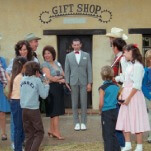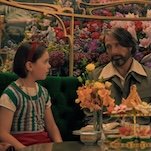George Takei captivates Jesse Thorn with World War II and Gay Rights
In Podmass, The A.V. Club sifts through the ever-expanding world of podcasts and recommends 10–15 of the previous week’s best episodes. Have your own favorite? Let us know in the comments or at [email protected].
Badass Digest
It Turns Out Rocky IV Sucks
The Badass Digest podcast is kind of a ramshackle affair. A few episodes back, a simple edit in a conversation between the show’s two hosts somehow resulted in 20 seconds of dead air. It’s an even more personal endeavor than its popular parent website, which itself is the work of just a handful of people. But aside from one rather vocal segment of the audience, podcast listeners tend to be forgiving of such DIY aesthetics, so long as there’s no skimping on the substance. And there’s plenty of substance here for any cinema enthusiast. For the past several weeks, Devin Faraci and Evan Saathoff have been giving more thought and consideration the Sylvester Stallone’s Rocky series than the vast majority of the world has in decades, charting the eponymous boxer’s fluctuations in intelligence and pathos versus the films’ shift from low-key drama to cartoon-esque quasi-mythology. They approach the films as both genuine fans and sophisticated critics, pointing out moments that made them cry and made them cringe. In this week’s episode—featuring Fangoria’s Samuel Zimmerman—they land at Rocky IV, not the last film in the series, but likely the last one that most people have any vivid memories of. And, well, as the title of the episode suggests, they find it somewhat lacking. [DD]
Bullseye With Jesse Thorn
George Takei, Damian Abraham
It’s hard to pinpoint when exactly George Takei transcended his lifetime role as a tertiary figure in television history and became a bonafide pop-culture phenomenon. Even five years ago, it would seem inconceivable that the old Asian guy who played Sulu on Star Trek could garner his own biographical documentary film, let alone one that was generating actual media buzz. But here we are. The 77-year-old outspoken gay rights activist carries with him a solemn gravity to his conversation with Jesse Thorn, as he recounts the many months he and his Japanese-American family spent penned by the the U.S. government during World War II and the many decades he kept his sexual identity hidden for fear of losing his acting career. This is not to say that the interview is entirely without levity. Takei’s memory of how fellow cast member Walter Koenig signaled to him that he was cool with his sexual orientation is among the more charming anecdotes to emerge from Star Trek’s golden age. Later in the episode, Thorn sits down with Damian Abraham, vocalist for Toronto-based hardcore band Fucked Up, to discuss how punk has changed the face of culture and how he’s managed to balance his music career with his responsibilities as a dad. [DD]
The Carson Podcast
Peter Jones
If one wanted to talk to performers who are a generation older than those who appear on every other podcast, it’s difficult to imagine a better angle than creating a program dedicated to Johnny Carson. Mark Malkoff built that better older-entertainer trap with The Carson Podcast, a weekly show that’s drawn Steven Wright, Charles Grodin, Florence Henderson, Rich Little, and Carol Burnett since its debut. While it doesn’t feature one of the show’s well-known guests, this episode with filmmaker Peter Jones is an excellent starting point for the podcast about a man who died five months before iTunes began offering podcast support. Jones, director of the magnificent documentary Johnny Carson: King Of Late Night, tells Malkoff about his dogged decade-plus persistence to create a film about the reclusive host. The pair share a Carson shorthand and deification that’s to be expected, but the conversation also reveals Jones’ humanity and passion for his subject. The director is repeatedly overcome with emotion while discussing Carson’s life and his own long journey to making the documentary. It’s a fascinating installment for a program that’s already logged about 20 Carson-centric hours and doesn’t sound like it’s running out of steam anytime soon. [TC]
99% Invisible
Thomassons
Can an artistic movement named after someone whose entire family despises it still be a legitimate source of expression and curiosity? Roman Mars makes a strong case for the architectural movement known as Thomassons, despite its namesake disavowing it altogether. Thomassons were first noticed (and named) in 1972 Japan by Akasegawa Genpei, and have since become a worldwide curiosity (see the 99% Invisible website for a variety of photographs documenting it). Thomassons are urban leftovers and architectural dead-ends, such as windows with gutters built over them and floating doorways high above ground level. They were nicknamed after a highly successful American baseball player who was acquired by a Japanese team only to watch his career flounder and fade into relative obscurity. Not only does the architectural phenomena and its origins in Japan lead to a fascinating story of modern civilization, but the episode ends on a powerful personal twist. Photos of the movement have had their own exhibitions and books about them have been published internationally, but the family of baseball player Gary Thomasson absolutely loathes the nicknaming of this movement. Sadly their perspective is only anecdotal (they once sent an exhibition a large picture of an extended middle finger) but this additional perspective gives the story a powerful human ending that Mars is forced to weigh in on. [DT]
No Such Thing As A Fish
No Such Thing As A Yawning Psychopath
Continuing a string of especially hilarious episodes of No Such Thing As A Fish, the researchers of BBC show Q.I. have unearthed facts as interesting as ever and their riffing is extra goofy. The kickoff story concerns the banning of growing a beard during wartime while in Alexander The Great’s army. This leads to a historical beard tangent that trails all the way through the first World War, ending with a great deconstruction of Blackbeard, who apparently tied lit dynamite fuses into his facial hair in order to intimidate his enemies. A particularly long scientific discussion leads through the mystery of yawning. It’s still not clear why it happens, though at least a dozen theories ranging from heating to anxiety are shared. But the highlight of the episode may be a particularly silly stretch early on that dances around a bit of 12th century Indian scripture called The Koka. Women with beards cannot become married for a huge list of reasons, including but not limited to unusually disproportionate toes; inverted nipples; sighing during meals; and being named after trees, birds, or mountains. Fans of Pixar’s Toy Story will also learn a remarkable story about how close the movie Toy Story 2 was to being completely annihilated. [DT]
Radiolab
Hello
Be prepared for an onslaught of high-pitched squeaks in this week’s engaging, if not slightly unsettling, dolphin-centric episode of Radiolab. Told in two parts, the producers look at humanity’s attempts to communicate with the slippery-smart animals. The first story focuses on Margaret Howe, who controversially shared a flooded apartment with a dolphin named Peter in the ’60s. The scientist behind it all was one of the first to think that animals might have more going on behind the scenes than yips and yaps, and tapped Howe to teach Peter, the dolphin, English. The segment makes wonderful use of archival recordings, especially in contrast to current-day interviews with Howe. Smartly, the offhanded sexual relationship forged between woman and dolphin is relegated to footnote status. The second segment flips the Howe’s situation on its head, following a team of modern-day scientists trying to decode dolphins’ clicks and gargles into English. The story is still developing, so there aren’t many results to ponder, but listeners do get to meet a hilarious programmer who found himself chasing down dolphins after working on Google Glass. The producers don’t learn much by the end of the episode, but it seems they experienced way more than they thought they would. [MK]
Sawbones
Spontaneous Combustion
A medical podcast with a focus on bodily humors and such, Sawbones translates well into a live format. And there is no more strange, mythical, and dramatic medical event than the topic of this particular episode—spontaneous human combustion. Tackling its origins and likely cause are the husband-and-wife, doctor/humorist team of Dr. and Justin Sydnee McElroy. Though much of the research Dr. Sydnee has done is speculative (there’s a supposed undiscovered element some say exists called a “pyrotron”) there are also enough documented cases to make her take it seriously. One particular article in 1823 discovered some common traits—most victims tend to be alcoholics, elderly females are more likely to be victims, and usually the body had contact with some kind of lighted substance. Though the last observation nearly negates this entire article, the other two qualities also come up in other research done. And for everything Justin is able to debunk with some rationalization, Dr. Sydnee has another creepy detail to color the death scenes, such as the only things burning being human trunks, abdomens, and heads while unburned limbs and rooms remain behind. Taped in New York City, the group of rowdy fans earns plenty humorous intent from both hosts as they play to the crowd. [DT]
Stuff You Missed In History Class
The Heathen School
Many episodes of Stuff You Missed In History Class attempt to provide an objective perspective to what, at the time, might have been considered a practical cultural event but in present day is a bit disturbing. In this episode of SYMIHC, Tracy V. Wilson and Holly Frey describe a time when America underwent a particularly restrictive religious conversion. During the early 1800’s The Foreign Mission School in Cornwall, Connecticut spearheaded the Christian Revival Movement. It inspired many churches to try and convert “heathen” communities from the inside out by drawing in leaders and artists and sending them back out into their supposedly lesser cultures. The ultimate success of the movement also led to its ultimate failure—while Christianity and its tenets continued to prosper with similar tones to this day, there are some especially ironic failures of the 1800’s period. The racial undertones are brought to the front of the conversation and make a strong case for why racial dialogues in America are often buried beneath conversations about religion. Frey and Wilson are legitimately amused by these failures; many of the documents at the time stated quite clearly that despite the school’s noble intentions they very much wanted to convert in order to acquire and repopulate other peoples’ land. [DT]








































